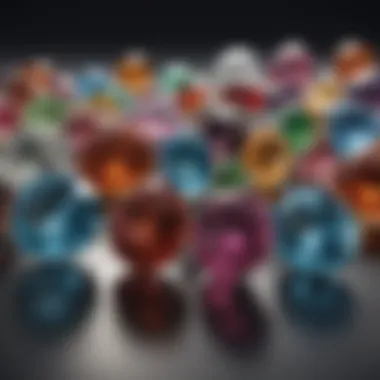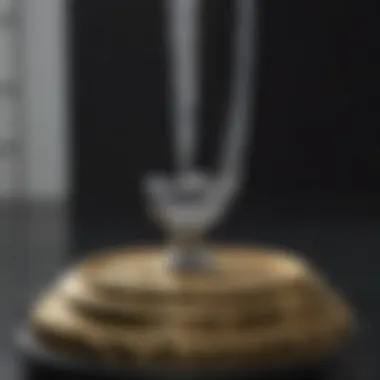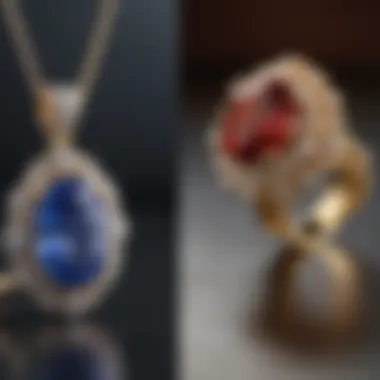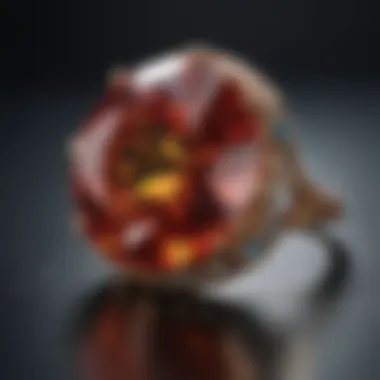Understanding CTTW in Jewelry: A Comprehensive Guide


Intro
CTTW, or carat total weight, serves as a fundamental concept within the jewelry sector. Understanding this term is paramount for both buyers and sellers in navigating the intricate world of gemstones. CTTW offers insight not just into the weight of individual stones, but into the overall significance of a jewelry piece.
Gemstone Overview
Definition of Gemstones
Gemstones are naturally occurring minerals or organic materials that possess crystal structure and beauty. They are often cut and polished for use in decorative items, especially jewelry. Gemstones can range from precious stones like diamonds and rubies to semi-precious options such as amethyst and garnet.
The value of gemstones is often assessed based on several criteria, including rarity, color, clarity, and cut. Each of these factors plays a role in determining not only the aesthetic appeal but also the monetary worth of the gemstone.
Classification of Gemstones
Gemstones can be classified into two primary categories: precious and semi-precious.
- Precious Gemstones: These include diamonds, rubies, sapphires, and emeralds. They are valued for their rarity and beauty.
- Semi-Precious Gemstones: This category encompasses a wide variety of stones like amethyst, aquamarine, and opal. While they are not as scarce as precious stones, they can still be stunning and valuable.
Each category also contains various types, classified based on characteristics such as chemical composition and crystal structure. Understanding this classification helps buyers make informed decisions when purchasing jewelry.
Historical Significance
Origins of Gemstone Use
The use of gemstones has deep historical roots. Humans have adorned themselves with gemstones for thousands of years, often using them as a form of currency, in trade, or for decorative purposes. Some of the earliest evidence of gemstone use dates back to ancient civilizations, where they were thought to hold mystical properties.
Cultural Insights: Gemstones in Ancient Civilizations
Throughout history, different cultures have placed significant value on certain gemstones, imbuing them with various meanings and beliefs. For instance, in ancient Egypt, lapis lazuli was revered for its rich, deep blue color and was often used in burial artifacts. Similarly, in ancient Indian culture, gemstones were associated with astrological significance and used in Ayurvedic practices. This historical context illustrates the profound importance of gemstones across various societies and underlines the ongoing relevance of CTTW today as it ties into real-world practices and traditions.
The historical use of gemstones not only demonstrates their aesthetic value but also their cultural significance, influencing modern perceptions of CTTW.
Defining CTTW
Defining CTTW is crucial in understanding its role in the world of jewelry. CTTW, or carat total weight, is a measure that combines the weights of all the individual gemstones in a piece of jewelry. This measurement is essential as it provides consumers with a clear indication of the total weight of gemstones they are purchasing. Without an understanding of CTTW, buyers might not fully appreciate the value or quality of their purchases.
With the jewelry market being vast and varied, knowing how to evaluate CTTW can make a significant difference in making informed decisions. This segment of the article covers foundational aspects, allowing enthusiasts and potential buyers alike to grasp the intricacies associated with carat total weight and its implications for jewelry valuation.
What Does CTTW Stand For?
CTTW stands for Carat Total Weight. The term emphasizes the total weight of all gemstones contained in a piece of jewelry rather than individual weights. Understanding that CTTW reflects the sum of all carats allows buyers to comprehend how the weight influences the pricing and perception of a jewelry piece.
For example, a ring featuring several smaller diamonds may list a CTTW that gives an impression of higher value than if viewed through individual carat weights. This understanding helps in assessing the worth of the item and ensures buyers are aware of what they are truly investing in.
The Meaning of Carat and Weight
Carat is a unit of weight used for gemstones and pearls. One carat is equivalent to 200 milligrams. This measurement determines the gem's size and, indirectly, its value. When it comes to weight, it is essential to distinguish between the carat weight of individual stones and the total weight represented by CTTW.
The significance of weight extends beyond mere numbers. It impacts aspects like appearance, pricing, and even the wearability of jewelry. Higher carat weights generally command better pricing, but this is not always linear. Factors such as gemstone quality, cut, and setting types also play crucial roles.
In summary, recognizing the relationship between carat and weight is vital for any buyer or designer. It sets the groundwork for evaluating jewelry pieces accurately and ensures an understanding of their inherent value.


The Importance of CTTW in Jewelry
CTTW, or carat total weight, significantly impacts the jewelry industry. It provides both consumer and seller with vital data. Understanding CTTW is essential for several reasons. First, it influences pricing in a direct way, allowing buyers to gauge the value of a piece based on its weight. Moreover, it helps in establishing standards within the market. Second, CTTW is an important factor in assessing aesthetics—how a piece looks can often correlate with its total weight, particularly in rings, earrings, and necklaces. With this in mind, understanding CTTW enriches the buying experience for consumers and assists sellers in setting appropriate prices.
How CTTW Affects Pricing
CTTW plays a critical role in determining the pricing of jewelry. Generally, the higher the total carat weight, the more expensive the piece will be. Buyers consider CTTW when comparing pieces, as larger gemstones are often perceived to be of higher quality, thus driving up demand. Jewelers typically price items based on the weight of the gemstones used, which reflects in the final price.
Here are some factors how CTTW affects pricing:
- Gemstone Type: Certain stones, like diamonds, may fetch a premium per carat compared to others.
- Market Demand: Trends can affect how much potential buyers are willing to pay for specific CTTW levels.
- Quality of Stones: High-quality gemstones can command a higher price, irrespective of weight.
Understanding these elements helps buyers recognize how much they should be willing to spend for a piece they admire.
Market Trends and CTTW
Market trends significantly shape the importance of CTTW in jewelry. Styles and preferences change over time, influencing how consumers view the value of certain weights. For instance, during certain periods, larger stones may be more favored in ring designs, thus increasing market demand for higher CTTW pieces.
- Luxury Market Growth: The increase in wealth among certain demographics has led to a rise in demand for high CTTW jewelry, illustrating the idea that bigger may be better.
- Sustainable Practices: Some consumers now prioritize ethical sourcing over CTTW, impacting how certain pieces are valued today.
Being aware of these trends allows both buyers and sellers to make informed decisions in the evolving marketplace.
Distinguishing CTTW from Other Measurements
Understanding how CTTW, or carat total weight, interacts with other measurements is crucial for both buyers and sellers of jewelry. This differentiation helps enthusiasts and investors make informed decisions when purchasing jewelry or gemstones. The term CTTW often causes confusion since it encompasses more than just the individual weights of the stones involved. Clarity on this topic enhances one’s overall appreciation of jewelry valuation.
Carat Weight vs. Total Weight
Carat weight specifically refers to the weight of a single gemstone. This is essential for evaluating the quality and cost of that gemstone. For example, a one-carat diamond is usually more desirable than a smaller one but less significant if the diamond’s clarity and color are inferior.
Conversely, total weight includes all gemstones in a piece of jewelry. It sums their individual carat weights to provide a complete picture of the overall value of the piece. Thus, a ring featuring three diamonds of one carat each has a CTTW of three carats. This distinction is crucial when assessing price. A higher CTTW might increase the jewelry's cost dramatically, but it's essential to regard the quality of each gemstone within that total weight.
Understanding Weight Distribution in Jewelry
Weight distribution is a vital aspect to consider when evaluating jewelry. The overall look and feel of a piece can be significantly affected by how its weight is distributed. For instance, a necklace with a high CTTW might use small stones, leading to a lighter overall feel, whereas a piece with fewer larger stones might feel heavier and more substantial, even if the total weight is similar.
Consumers also need to understand that not all designs maximize the visual impact of the CTTW. Some settings may obscure gemstones or create an illusion of lesser weight. Therefore, it is imperative to consider both the carat weight and its design. This understanding aids buyers in assessing the true value and beauty of the jewelry they are interested in.
"Understanding the nuances of CTTW compared to other measurements can significantly enhance your investing and buying experience in the gemstone market."
CTTW in Different Types of Jewelry
CTTW, or carat total weight, is a critical consideration when evaluating different types of jewelry. It serves as a standard measure for assessing the weight of gemstones, thereby influencing both the aesthetic appeal and market value of the piece.
Rings: Setting the CTTW Standard
In rings, a high CTTW often indicates not only the presence of larger gemstones but also the intricacy of the design. Couples look for engagement rings that showcase impressive carat weight. A single larger diamond, for instance, can create a more striking visual impact than multiple smaller stones.
However, it’s important to consider that the overall style can affect how CTTW is perceived. For some designs, a balance of smaller stones may enhance the ring’s elegance without overshadowing the wearer’s hand. Additionally, consumers should verify that the quality and color of the gemstones are consistent with higher CTTW.
Earrings and CTTW Considerations
When it comes to earrings, CTTW can vary significantly based on style and occasion. Stud earrings typically prioritize carat weight to create a bold look, appealing to individuals who want to make a statement. In contrast, dangling earrings may distribute weight across multiple stones, capturing light in different ways. This variation can affect not only how earrings look but also how comfortable they are to wear.


Buyers should also consider how CTTW impacts earring backs and settings. A heavier pair might require sturdier backing to ensure they stay secure. The perception of value is also closely tied to the number and quality of the stones, making it essential for buyers to assess all attribution factors.
Necklaces: Evaluating CTTW in Design
Necklaces reflect versatility in the application of CTTW. A simple pendant may feature a single gemstone with a high carat weight, creating a focal point that attracts attention. On the other hand, gemstone necklaces can utilize multiple smaller stones, offering a richer look. The arrangement and layout of these stones are crucial in defining the overall aesthetic and the perceived value.
CTTW in necklaces also involves understanding the purpose of the piece. For daily wear, light-weight designs with a moderate CTTW may be more practical, while statement pieces intended for special occasions can boast a higher carat weight. This adaptability shows how crucial it is to evaluate CTTW relative to overall design and functionality in jewelry.
"When investing in jewelry, consider how CTTW complements the design rather than just focusing on weight alone."
In summary, focusing on CTTW in rings, earrings, and necklaces reveals essential insights into both aesthetic choices and practical considerations. Buyers should engage with the nuances of CTTW to make informed decisions that align with their preferences and needs.
Consumer Awareness and CTTW
Understanding carat total weight (CTTW) is vital for consumers interested in jewelry. Awareness of CTTW helps buyers make informed choices, especially when evaluating the value of gemstones. The significance of this knowledge cannot be overstated, as it affects purchasing decisions and long-term satisfaction with jewelry investments.
- Know the Basics: Understanding CTTW allows buyers to differentiate between the total weight of all stones in a piece versus the individual weights. This distinction is crucial for assessing value accurately. Many individuals assume the total weight is directly tied to the quality of the stones, though this is not always the case.
- Pricing Implications: CTTW directly impacts pricing in the jewelry market. Higher CTTW often means a higher price. However, the value does not solely come from weight; the quality of the gemstones also plays a significant role. Consumers should be aware that a larger CTTW does not guarantee superior quality.
- Insurance and Resale Value: Knowing the CTTW is also important for future considerations like insurance. A proper appraisal based on CTTW helps in setting a fair insurance value, ensuring that one is well-protected in case of loss or theft. Furthermore, understanding the impact of CTTW can assist in assessing the potential resale value of jewelry.
What Buyers Should Look For
When examining jewelry, there are several factors related to CTTW that buyers should be attentive to:
- Certification: Look for pieces that come with certifications from recognized gemological institutes. This documentation often details the carat weight and quality, providing transparency on what you are purchasing.
- Quality Over Quantity: While a greater CTTW may be appealing, prioritize the overall quality of each gemstone. High-quality stones can outperform lower-quality, larger stones in terms of aesthetic appeal and value retention.
- Setting Style: The way stones are set can affect the perceived weight of the piece. Pay attention to the overall design and how it showcases the stones, as they can drastically change the piece’s visual impact.
How CTTW Influences Aesthetic Choices
CTTW can define the aesthetic appeal of jewelry, influencing choices made by consumers. Consider the following:
- Proportion and Design: A higher CTTW can alter the way a piece appears. Larger stones can create a bold look, whereas a lower CTTW might allow for intricate designs that utilize smaller stones effectively.
- Visual Balance: Buyers should consider how CTTW affects the overall visual balance of the jewelry. This is especially important for engagement rings and earrings where the total weight can significantly impact their presence.
- Personal Style: Ultimately, the choice of CTTW should align with personal style preferences. Some may prefer multiple small stones that create a sparkling effect, while others might lean towards a single, larger stone for an elegant look.
"Understanding CTTW is not just about numbers; it is about making choices that resonate with personal taste and values."
By grasping these elements related to CTTW, consumers can deepen their appreciation for jewelry while ensuring their purchases align with their desired quality and aesthetic.
Evaluating CTTW's Impact on Investment Value
Assessing the significance of CTTW, or carat total weight, in jewelry investment cannot be overstated. Understanding how CTTW correlates with the potential appreciation of gemstones helps investors make sound choices. The value of jewelry often hinges on the quality and design, but the CTTW remains a crucial metric that influences perceived worth.
CTTW and Gemstone Appreciation
CTTW directly affects an item’s market appeal. A higher CTTW generally suggests a piece is more valuable. However, it is critical to pair this with the quality of gemstones. For instance, a ring featuring large diamonds with a total carat weight of three may be more appealing than one with three smaller stones weighing one carat each, despite them having the same CTTW. This perception can lead to higher demand and, ultimately, appreciation in value.
Investments in gemstones are not without challenges; the rarity and desirability of the stone play a significant role in its appreciation. For example, a one-carat fancy yellow diamond will likely show different appreciation metrics against other diamonds due to its rare color. Thus, while CTTW is essential in assessing worth, gemstone characteristics and market demand remain equally significant in determining long-term value.
Risks Associated with CTTW Investments
Investors must also consider the risks that come with focusing heavily on CTTW when investing in jewelry. Misunderstandings about CTTW can lead to poor buying decisions, as not all high CTTW pieces are created equal. The possibility exists that buyers may overpay for stones based solely on total weight without considering quality factors such as cut, clarity, and color.
- Overvaluation: In some instances, high CTTW might mask poor quality stones, leading to inflated prices.
- Market Fluctuations: The jewelry market can be volatile. Prices can depend on broader economic factors and shifting consumer trends, often independent of CTTW.
- Liquidation Challenges: Selling jewelry at an appreciated value can be difficult, especially if buyers are more educated about CTTW and the quality factors.
CTTW: A Buying Guide
CTTW, or carat total weight, plays a significant role in the purchasing process of any jewelry piece, particularly those that feature multiple gemstones. When browsing for jewelry, understanding CTTW can help buyers gauge the overall value of an item. This section will discuss the key aspects of CTTW as it relates to buying jewelry, blending both analytical insights and practical advice for consumers.


Finding the Right Balance
In jewelry, striking the right balance between carat total weight and other qualities is essential. While CTTW gives an overall measure of how much weight is present in the piece, it does not directly reflect the quality of the individual stones. Buyers should focus on both the total weight and the respective qualities such as cut, clarity, and color of each gemstone.
- Consideration of Quality: A high CTTW may seem attractive, but if the individual stones are of lower quality, the overall appeal diminishes. Balance is key.
- Setting and Design: The way gemstones are set can impact how they are perceived. A thoughtful design can highlight smaller stones effectively, ensuring that the total weight does not overshadow the unique beauty of each gem.
- Personal Preference: Buyers should reflect on their personal style. Some prefer pieces with larger stones, while others may be drawn to intricate designs with many smaller gems.
Analyzing the Total Weight in Context
Understanding CTTW requires more than just a number. Analyzing the total weight in context involves looking at the entire piece of jewelry, including how the design incorporates that weight.
- Setting Style: Different styles of settings can influence perception. A piece with a substantial CTTW in a delicate setting may feel opulent, while a heavier piece in a robust design can come off as clunky.
- Gemstone Arrangement: How the gemstones are arranged can often dictate how the CTTW feels. A well-balanced arrangement of multiple stones can enhance the allure of the jewelry, making the total weight work to the buyer's advantage.
- Market Standards: It is also wise to compare CTTW against market averages for similar pieces. This knowledge provides a perspective on the value, ensuring that buyers do not overpay or undervalue a piece based on weight alone.
Always remember, CTTW is just one piece of the puzzle. The beauty of jewelry often lies in the details that CTTW alone cannot quantify.
By understanding the interplay of these elements, buyers can make more informed decisions when considering jewelry purchases based on CTTW. This approach not only enhances the buying experience but also ensures that the investement in jewelry is a reflection of both value and personal taste.
Challenges in CTTW Evaluation
Understanding the challenges in CTTW evaluation is crucial for both buyers and sellers in the jewelry market. CTTW, or carat total weight, is often misunderstood, leading to misinterpretations that can affect purchasing decisions. Key elements here include common misconceptions that surround CTTW and how the quality of gemstones plays an essential role in overall evaluation. Knowing these challenges enables informed decision-making for enthusiasts and collectors alike, ensuring that they grasp not only the numbers associated with CTTW, but also the broader implications of these figures.
Common Misconceptions
One of the primary challenges in evaluating CTTW is the prevalence of misconceptions that often surround it. For example:
- CTTW Reflects the Quality of Stones: Many assume that a higher CTTW always means better quality. In reality, quality is equally governed by cut, clarity, and color. A piece may have a high CTTW, yet lack the brilliance found in lower-carat alternatives.
- Total Weight Equals Value: Some buyers may believe that simply having a higher total carat weight guarantees a higher price. However, the market often values quality over quantity.
- All Stones Count Equally: Occasionally, consumers believe that all stones in a piece are of equal significance. In fact, several smaller stones may have diminished visual impact compared to a single larger stone, despite their total weight.
These misconceptions can influence buyer behavior, ultimately affecting satisfaction with the purchase made. Thus, addressing these issues is essential for achieving a better understanding of CTTW and its real implications in jewelry.
The Role of Gemstone Quality in CTTW
When discussing CTTW evaluation, the quality of gemstones involved cannot be overlooked. Higher quality gemstones can command significant price differences per carat compared to lower quality stones. While CTTW will denote weight, it does not necessarily translate to intrinsic value.
For instance:
- Clarity: Gems with higher clarity usually command higher prices. A flawless diamond will be valued higher than one with visible inclusions, even if both have the same CTTW.
- Cut: The way a gemstone is cut influences its light performance and, consequently, its appeal. A well-cut stone will shine brighter and display better aesthetics, despite weight.
- Color: Especially in gemstones like sapphires and emeralds, color depth and richness heavily influence valuation. A lighter shade may not have the same market acceptance as a deeply colored stone, regardless of CTTW.
In summary, CTTW is a numeric measure but does not fully envelop a gemstone's value. Buying or selling jewelry necessitates consideration of all quality factors involved.
"The real worth of a piece of jewelry often transcends mere numbers; understanding the nuances of gemstone quality is essential for appreciation."
Concluding the exploration of challenges in the evaluation of CTTW, it becomes clear that both buyers and sellers benefit from understanding these intricate details. This knowledge helps foster a more informed market, enhancing overall satisfaction with each purchase within the jewelry sector.
Culmination: Understanding CTTW's Role in Jewelry
Evaluating CTTW can help consumers avoid common pitfalls. Misunderstandings about this term can lead to a miscalculation of a piece's value. Knowing the differences between carat weight and total weight can guide buyers in making smarter choices. This understanding reinforces both confidence in their purchasing decisions and satisfaction with their investments.
Recap of Key Takeaways
- CTTW is a significant factor in determining the value of jewelry.
- It is essential to differentiate between carat weight and CTTW to accurately assess the worth of items.
- Buyers should consider the impact of CTTW on aesthetics and market appeal, particularly in elaborate multi-stone designs.
Encouraging Informed Purchasing Decisions
Informed decisions are paramount in the jewelry market, especially regarding CTTW. By understanding what CTTW signifies, buyers enable themselves to engage critically with their purchases. They should proactively seek out quality information, perhaps from respected resources like Wikipedia or jewelry experts on forums such as Reddit.
Considerations include not only CTTW but also the quality of the gemstones involved. Investing time in research can unveil details about certification, the reputation of sellers, and current market trends. Knowledge about CTTW can ultimately translate into better investment choices that align with one's values in terms of beauty and rarity.
"An educated consumer is an empowered consumer."
By synthesizing the information about CTTW presented throughout this guide, readers gain insights that serve as a foundation for confidence in their jewelry engagements. Understanding CTTW is not merely beneficial; it is essential for anyone looking to navigate the intricate world of jewelry with skill and acumen.



